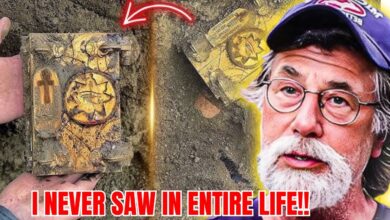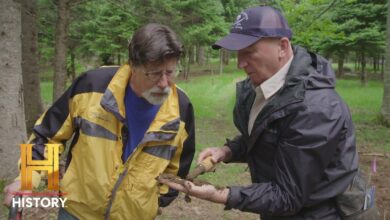The Hunt for BIG Treasure Continues (Season 12) | The Curse of Oak Island
The Hunt for BIG Treasure Continues (Season 12) | The Curse of Oak Island

NARRATOR:
A morning of unrivaled hope has begun on Oak Island for brothers Rick and Marty Lagina and their team…
So, they’re taking out the north corner of Shaft Six. That’s probably the beams we’re seeing.
NARRATOR:
…because as they unearth the remains of a 19th-century searcher shaft in the fabled Money Pit area, they have compelling reasons to believe that it will lead to the answers of a 230-year-old mystery.
STEVE:
So, at the bottom of this hole, we should catch part of the tunnel going from Shaft Six to the Money Pit. So we should see a lot of wood.
RICK:
That would be the hope, but we’re looking for the… something that was in the tunnel or in the shaft.
STEVE:
Yeah.
OTHERS:
Yeah.
One coin, two coins, 100 coins. Even part of an authentic chest.
RICK:
Anything.
NARRATOR:
In the summer of 1861, members of the Oak Island Association reportedly drilled through two stacked treasure chests at a depth of nearly 110 feet in the original Money Pit.
Believing that a man-made flood tunnel would stop them from reaching the chests, they dug an adjacent shaft 18 feet to the west—known as Shaft Six—down to a depth of 118 feet.
From there, they began tunneling toward the Money Pit, hoping to recover the treasure from safely below the deadly booby trap.
The colossal effort failed. Just before reaching their target, seawater rushed in.
The disaster not only forced the searchers to abandon Shaft Six but caused tons of lumber and the believed chests in the Money Pit to collapse, leaving a debris field and the valuables entombed inside of the tunnel.
GARY:
All that old wood’s still coming up.
NARRATOR:
One week ago, while excavating a seven-foot-diameter shaft known as RP-1, the team unearthed evidence of the Shaft Six tunnel: iron straps potentially related to wooden containers, and a pipe stem that was dated to as early as the late 17th century—more than 100 years prior to the discovery of the Money Pit.
Now the team is digging a second shaft, dubbed RP-2, just northeast of RP-1 in the hopes that, this time, they will recover the contents of the two legendary treasure chests.
MARTY:
Do we have some excitement level here?
ALEX:
Hey.
OTHERS:
We are. We’re ready.
It’s coming. It’s building. Let’s go.
NARRATOR:
Rick has joined his brother Marty and other members of the Oak Island team in the Money Pit area, after receiving word that the RP-2 caisson has reached a depth of 105 feet below ground… just 13 feet from where they hope to intercept the Shaft Six tunnel.
RICK:
I see no reason not to have a lot of hope today because nothing we see suggests in any way, shape or form that the narrative is not correct.
Okay. Who’s in?
OTHERS:
I’m in.
I’m in.
Got a shovel.
GARY:
Yeah.
TERRY:
We’re all in.
MARTY:
Everybody’s in.
RICK:
We’re getting close to the tunnel. It’s somewhere between 112 and 120, certainly.
GARY:
Ooh, that looks like an old timber, doesn’t it? Some big pieces.
RICK:
But for right now, I’m short of that one thing that proves the treasure is real and that one thing is everything to me.
(♪ ♪)
TERRY:
Oh, wow. Look at that.
RICK:
That’s great.
MARTY:
What’s that? A big piece of wood? It’s adze-cut.
NARRATOR:
Adze-cut wood?
An adze is an ancient cutting tool that was long used in construction until mechanized saws were invented during the late 18th century.
If this timber was indeed shaped with an adze, could it—just like the previously found wooden dowel—have come from the original Money Pit?
GARY:
Oh, look at that. Look at that.
ALEX:
Yeah. See the line on the edge?
ALEX:
Yeah. Like a barrel. Think it might be a barrel?
GARY:
Yeah.
OTHERS:
That is a barrel.
A barrel, a barrel stave.
That’s a barrel.
TERRY:
Rick, that looks like a barrel stave.
RICK:
Yeah. Wow. Wasn’t there like a top of a keg that they grabbed out of the original Money Pit?
TERRY:
Absolutely.
NARRATOR:
During the catastrophic collapse of the original Money Pit in 1861, which is believed to have left a debris field of wood and scattered treasure in the Shaft Six tunnel, a worker recovered the top of a wooden keg, or barrel, just before escaping with his life.
This has led many to speculate that, in addition to the two stacked chests, the Money Pit may have also contained barrels full of possible valuables.
TERRY:
Well, that’s pretty cool.
OTHERS:
Absolutely.
Pretty bloody cool.
Yeah. That fits the narrative perfectly.
It wasn’t just food and water in barrels.
They used to put coins in barrels.
Yeah.
This is good.
This is real good.
LEE:
Cutting through something hard.
JARED:
You’re in something hard?
LEE:
It jumped from 130 to 160. The pressures on the oscillators just changed. We’re about at 116 feet with the casing teeth. Pressure is going up.
OTHERS:
What does that mean?
LEE:
Well, they’re cutting into something harder. So it could be something we don’t know anything about.
GARY:
Going in.
NARRATOR:
The question now is, could it be something of great importance or value?
MARTY:
Well, that’s looking like the bottom.
GARY:
Yeah. Wow, there’s nothing in here, this is quiet. Ugh.
GARY:
I think we’ve come to the end of the line.
RICK:
That stuff’s so thick. It’s starting to get into… in situ stuff.
TERRY:
Definitely there’s more in situ.
No big chunks that you’d find laying on the bottom.
No. Unfortunately, looks like we’re getting out of her.
OTHERS:
Where’s the coinage?
Well, it’s certainly not here.
No. It looks like it’s petering out.
Forget me, it’s all about Gary.
You know, if he’s not finding it.
TERRY:
As far as geology, yeah, we’re getting into in situ.
RICK:
Yeah.
TERRY:
And we’re done, I think.
RICK:
Yeah, we are.
NARRATOR:
The recovery of “in situ” soils is a troubling development.
It likely means that the obstruction in RP-2 was merely the bottom of the Shaft Six tunnel and the team is now digging through undisturbed earth below their target area.
VANESSA:
I did tell Rick earlier that we thought you were cutting through wood and your pressures, and then you said the pressures changed again. So, can you get him up to speed?
LEE:
I was cutting about 120, 130, which is pretty low.
VANESSA:
So, you think you’re through the wood?
LEE:
Yeah, I think we’re through. This is just hard, hard material.
OTHERS:
Yeah. It’s dry.
It doesn’t– the teeth don’t like that.
RICK:
Yeah. I just think we’re in situ soil at this point. So I think we have to call it.
There’s no question at this point that we’re on Shaft Six.
Now, what we need to do is properly locate the next can over the tunnel, and at that point, there either is something or there isn’t.
OTHERS:
Okay. All right, so we got one more shot at this area.
Right.
You can’t give up.
No.
I’m not giving up.
All righty.
Okay.
All right. Next one.
Thank you, John.
RICK:
What we found in RP-1 convinced me, certainly, and I think all of us, that a significant collapse had happened.
In RP-2, we found evidence of different constructs. It was impactful. The keg, the barrel stave was found.
It raised the expectations through the roof. Unfortunately, they weren’t born out.
We have high hopes with the next can location. You hitch up your boots, you get stuck in—as Gary calls it—and you move forward.
So I am the bearer of bad news, but I’m also the bearer of potentially fantastic news.
OTHERS:
Okay. You said fantastic news.
Yeah.
Fantastic news.
RICK:
From my perspective.








